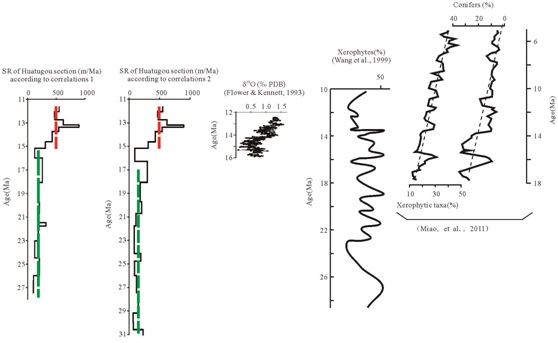Recent papers in Journals of Earth and Planetary Science Letters, Quaternary Sciences and others, have studied magnetostratigraphies, tectonic deformations and paleo-environmental changes of the Cenozoic sediments in and to the north Tibetan Plateau, demonstrate that once more uplift of the plateau occurred since 15 Ma and activity of the Tarim Basin initiated since early Quaternary.
The scientists suggested that development process of the basin-range structural pattern in the northeastern growth of the Tibetan Plateau should clue us formation of the whole plateau and climatic changes effects of these geomorphological deformations to the Asia and world. By using methods of Magnetostratigarphy and biostratography, CHANG Hong in the Institute of the Earth Environment and co-operators from his institute and universities in America suggested sediments span from Oligocene to late Miocene in the Huatugou section in northwest Qaidam Basin. And sedimentation rate abrupt increase since 15 Ma and other evidences suggested tectonic deformations have strengthened in the Altyn Tagh, Kunlun and Qilian Mountains they embrace the Qaidam Basin in that time. Deformation of ranges surrounding the Qaidam Basin can increase the elevation different between the basin and its source areas, thereby increasing the erosional flux to the basin. So, tectonics was the primary reason for the increase in sediment accumulation rate in the Qaidam basin since ~15 Ma.
Sedimentary environmental changes in Altyn Tagh in about 3.2 Ma according to the magnetostratographic, sedimentary and geomorphologic evidences in the Suerkuli section indicate that activity along the Altyn Tagh fault enhanced since late Pliocene if we rule out influences from coeval global and regional climatic changes in Pliocene to this sedimentary shift.
An abrupt decrease in the sedimentation rate is observed at 1.77 Ma in the uplift sub-basin units in the Tarim Basin on the basis of the magnetostratigraphy for the sediments drilled from eastern part of the basin. This period of sedimentary environmental change reveals that structural partitioning in the basement of the Tarim Basin occurred since early Pleistocene, sub-basin units of uplift and depression developing in that time.
All these evidences show that a new round of deformations and uplifts in the northeastern margin of the Tibetan Plateau started since middle Miocene. The geomorphical changes should be link to the remote effects of the collision between the Indian and Asian plates, and impacted climate changes in the Asia and the world.

Fig.1 Cenozoic strata and fossils in the Qaidam Basin (Image by CHANG Hong)

Fig.2 Correlation between sedimentation rates during Oligocene - late Miocene in the Qaidam Bsin and regional and global climatic changes. (Image by CHANG Hong)
Related papers:
1、Hong Chang, Leyi Li, Xiaoke Qiang, Carmala N. Garzione, Alexander Pullen, Zhisheng An (2015). Magnetostratigraphy of Cenozoic deposits in the western Qaidam Basin and its implication for the surface uplift of the northeastern margin of the Tibetan Plateau. Earth and Planetary Science Letters, 430: 271-283.
2、Hong Chang, Zhisheng An, Weiguo Liu, Hong Ao, Xiaoke Qiang, Yougui Song, Zhongping Lai (2014). Quaternary structural partitioning within the rigid Tarim plate inferred from magnetostratigraphy and sedimentation rate in the eastern Tarim Basin in China. Quaternary Research, 81: 424-432.
3、Chang Hong, An Zhisheng, Liu Weiguo, Wu Feng, Qiang Xiaoke, Song Yougui (2014). Late Miocene-early Pleistocene paleoproductivity variations of the Lop Nor in the Tarim Basin and its implications on aridification in Asian Interior. Chinese Science Bulletin, 59 (28), 3650-3658.
4、Lydia Staistach, Nathan Niemi, Hong Chang, Marin Clark, David Rowley, Brian Currie (2014). A Cretaceous –Eocene depositional age for the Fenhuoshan Group, Hoh Xil Basin: Implications for the Tectonic evolution of the northern Tibet Plateau. Tectonics, 33, doi: 10.1002/2013TC003367.
5、Hong Chang, Zhisheng An, Feng Wu, Zhangdong Jin, Weiguo Liu, Yougui Song (2013). A Rb/Sr record of the weathering response to environmental changes in westerly winds across the Tarim Basin in the late Miocene to the early Pleistocene. Palaeogeography, Palaeclimatology, Palaeoecology 386: 364-373.
6、Hong Chang, Zhisheng An, Weiguo Liu, Xiaoke Qiang, Yougui Song (2012). Magnetostratigraphic and paleoenvironmental records for a Late Cenozoic sedimentary sequence drilled from Lop Nor in the eastern Tarim Basin. Global and Planetary Change, 80-81: 113-122.
7、Hong Chang, Hong Ao, Zhisheng An, Xiaomin Fang, Yougui Song (2012). Magnetostratigraphy of the Suerkuli Basin indicates Pliocene (3.2 Ma) activity of the middle Altyn Tagh Fault, northern Tibetan Plateau. Journal of Asian Earth Sciences, 44: 169-175.
Further details from Dr CHANG Hong, changh@loess.llqg.ac.cn, State Key Laboratory of Loess and Quaternary Geology, Institute of Earth Environment.
 © 2015 Institute of Earth Environment,CAS
© 2015 Institute of Earth Environment,CAS Address:No. 97 Yanxiang Road, Xi'an 710061, Shaanxi, China

 Location :
Location :